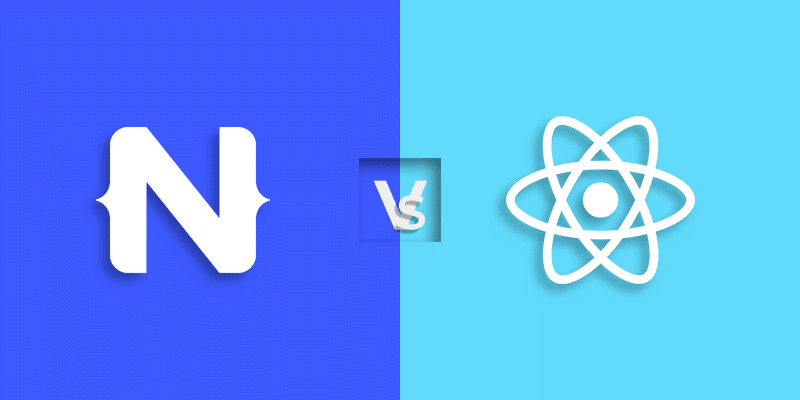For developing mobile apps you have a lot of frameworks and with these frameworks, you can develop applications that will run on both iOS and Android.
Today we will look at a comparison between NativeScript vs React Native.
We call these hybrid app development frameworks. In spite of many benefits, the biggest issue that such apps face is that they prevent accessing native components.
Moreover, instead of native rendering, they depend on the web view for rendering. This is where NativeScript and React Native appear as great solutions.

Now the question is what you should choose, NativeScript or React Native? Well, this is why we are here to present a comparative study of both frameworks.
What is NativeScript?
NativeScript is a versatile JavaScript framework popular for building native mobile applications that can run on both Android and iOS platforms. The framework allows building an app for both platforms using just a single codebase. Moreover, to ensure native user experience the framework allows access to the user interface, native APIs, and the rendering engines of both Android and iOS.
What is React Native?
React Native is a powerful JavaScript framework built by Facebook that is widely used to develop native applications for both Android and iOS mobile platforms. It is developed using the JavaScript library of the React framework. React is a framework that is already known for focusing on mobile platforms instead of user interfaces.
This allows the mobile app developers to make use of this JavaScript library while developing mobile applications boasting of native user experience and features. Moreover, the framework allows the developers to use the same code for both iOS and Android platforms.
Now that we have introduced the two frameworks, let us explain the key differences between them.
Learning Curve
Since both NativeScript and React Native depend on JavaScript code, frontend teams can easily use them. In case the developer team is already versed with ReactJS, they can quickly adapt to the React Native.
In complete contrast, Nativescript offers complete freedom to write the application code in their preferred JavaScript frameworks. They can use an array of combinations such as NativeScript + Angular, NativeScript + Typescript, NativeScript + VueJS, etc. But in the case of first-timers in cross-platform development, there is a little more steep learning curve.
The Common Benefits of Two Frameworks for Cross-Platform Development
In spite of all the differences that these two frameworks have, they also share some common benefits for developers. Let’s have a look at these common benefits.
- Shared Codebase
NativeScript and React Native are two advanced JavaScript frameworks that are known for their capability in sharing code for apps across iOS and Android platforms and the Web.
- Easy Maintenance
Because of the shared code across multiple platforms, maintaining app code and deploying any changes becomes easier.
- Cost-Effective and Faster Development
By using the single technology stack across the whole infrastructure they offer faster and cost-effective development advantages.
- Popularity
React Native enjoys more popularity as a cross-platform mobile development framework and it already enjoys an edge over other similar frameworks such as Xamarin, Flutter, Ionic, etc. Since React Native was developed by Facebook, it enjoyed a quick surge in popularity. In respect of popularity and company support, neither NativeScript enjoys such support like that of Facebook nor it has become widely used as React Native.
- Footprint and size
In case the project involves developing a cross-platform mobile app with complicated and multiple-layered business logic, React Native can be a better option. React Native apps have a smaller footprint and size and can consume fewer data. In contrast, NativeScript apps can be bigger sized and can consume larger data volume. If keeping the app size lean and consuming fewer data for faster loading speed is a crucial requirement for a complex app, React Native can be a better choice.
- Plugins and third-party tools
When you seek a complete repository of tools and plugins for meeting the needs of a particular development project, NativeScript can be a more ideal solution as it comes with a complete web resource loaded with plugins for any solution. With NativeScript on your side, taking help from third-party solutions becomes completely irrelevant. In the case of React Native, you cannot have such a dedicated repository of plugins except depending on the community support.
- App Performance and Speed
In terms of performance and speed, React Native is way ahead of NativeScript because of a number of reasons. Thanks to the use of Virtual DOM developers can easily enjoy easy rendering of the dynamic elements that normally can be found in all those apps built using native SDKs. Moreover, when responsiveness and faster loading speed are two important considerations for the app development projects, the rendering of NativeScript appears to be a lot slower.
- Native API Interaction
With the NativeScript framework, the developers can easily get access to native Android and iOS APIs. For developers, this means they don’t need any expertise in native development languages to start with. In contrast, for React Native development the developers don’t get such useful capabilities. For connecting with native APIs, React Native uses special bridges and this requires knowing relevant native languages. In that respect, it is important to know that ready to use bridges are built and made accessible for other React Native developers by the React community.
- Robust web community
Though both though React Native and NativeScript appeared almost around the same time, React Native has a larger developer community of NativeScript. This is mainly possible because the React Native framework was developed by the developers at Facebook who already made a dominant presence with the React framework. Besides the popularity of React Native ensured by the React community and Facebook, it has already been used successfully across a lot of leading apps and cross-platform projects across the niches.
Conclusion
In the final comparison, the most complex projects React Native appears to have a competitive edge. But NativeScript has also few areas of strength and choosing between the two requires a meticulous consideration of various differences between the two.





Leave a Comment